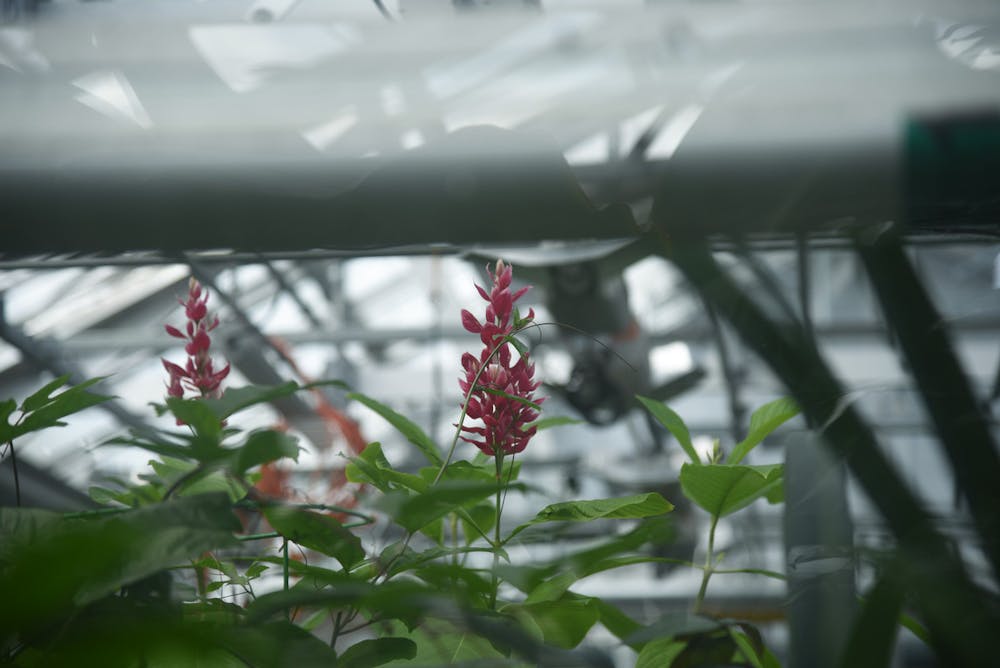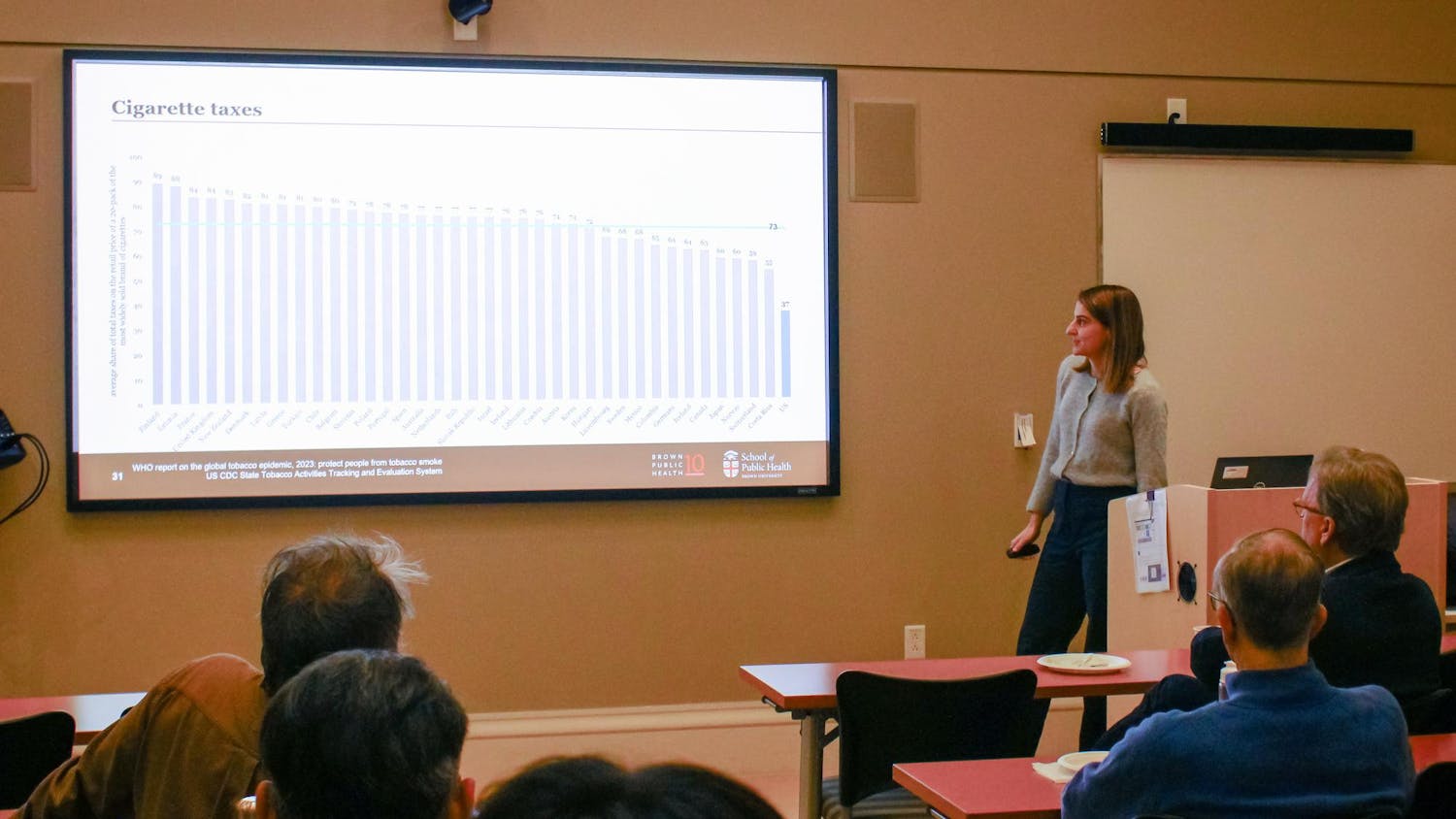At the Plant Environmental Center, located on the rooftop of the Institute at Brown for Environment and Society at 85 Waterman St., plants ranging from a bonsai tree over 35 years old to a collection of cycads — a prehistoric plant — find a space to grow and bloom. The Center consists of six computer-controlled greenhouses spanning a total of 5,000 square feet as well as a 1,800 square foot conservatory, creating a tranquil seating area amidst dozens of lush plants.
Roots of Brown greenhouses go back 50 years
Before the Center was created, there was a ground level facility in the place of today’s grassy walkway leading into Ruth J. Simmons Quadrangle for nearly 50 years, said Mark Johnson, associate professor of biology. Johnson started conducting research in Brown’s greenhouses in 2004.
“There were a lot of really nice things about the old greenhouse,” Johnson said. “One advantage was it was very public facing,” and people would walk in and visit often.
Fred Jackson PhD’17, former director of the greenhouses, started working at the University in 1992 and also served as a lecturer in ecology and evolutionary biology before retiring. In addition to research in the greenhouse, Jackson taught courses using the greenhouse space including BIOL 0190E: “Botanical Roots of Modern Medicine” and BIOL 0150C: “Methods for Extraction and Analyzing Secondary Metabolites of Medicinal Plants.”
“They hired me because they needed somebody to run the greenhouses, and that’s what I did for my whole career,” in addition to “teaching horticulture and everything else with plants and botany,” he said.
The old spaces were torn down and the Plant Environmental Center “rooftop oasis” opened in 2014 to “conserve precious green space” on campus and support botanical research and teaching on biology, ecology and environmental sciences, Johnson said.
The Plant Environmental Center gave Jackson his first opportunity to work in a brand new greenhouse fully equipped with advanced research technology since starting greenhouse work in the 70’s. Many of the exotic plants in the greenhouses were brought in through Jackson’s research. “During his research, he would source plants and bring them back and create connections in other parts of the world where we could reach out to them and get plants,” current Research Greenhouse Manager Nicholas Vasques said. Other plants are “brought in through seed from vendors,” he added.
A full-time team for a growing collection
In addition to the computer-controlled greenhouses on the rooftop, the Plant Environmental Center also has other “support spaces” in the basement, including the headhouse, growth chambers and laboratory classrooms for plant-related courses, Johnson said.
The headhouse has microscopes that researchers can use to analyze samples and materials for transplantings. Growth chambers also provide space for plants to grow in controlled environments where researchers can set specific temperatures, light intensity, amount of CO2 and humidity, according to Johnson.
Vasquez runs the Plant Environment Center’s day to day operations and is responsible for keeping the “teaching collections and research experiments healthy,” he said. He ensures that each plant receives the correct amount of nutrients, creates pest management plans and “makes sure that all of the greenhouses are functioning properly — there’s a lot of electronics, sensors and equipment in here.”
Vasquez and other greenhouse staff also support researchers by watering plants and notifying them of any changes or developments in their projects.
“That there is a full-time staff for the greenhouses is really what makes it so valuable to Brown as a research institution,” said Audrey Massmann GS, who conducts research in one of the greenhouses. “The staff at the greenhouse have played a huge role in my education at Brown.”
Massmann added that she can draw on the “horticultural knowledge” of the staff and has “learned a lot from them about being able to look at a plant and tell what’s going wrong with it.”
Seeds bloom into research projects
Massmann’s work, which is in collaboration with Professor of Ecology and Evolutionary Biology Stephen Porder, lies within the field of tropical terrestrial biogeochemistry. She studies the cycling of elements like carbon and nitrogen through tropical forests with the species Neustanthus phaseoloides.
While climbing plants like Neustanthus phaseoloides abound in tropical forests, they are not as present in temperate forests like the ones around Rhode Island, according to Massmann. The plants “climb up trees” and “take advantage of (the) photosynthetic real estate” of trees instead of producing their own wood. “I became really interested in this life strategy,” Massmann said.
She visits the greenhouse every few days to tend to these plants, giving half of them bamboo sticks to climb on while leaving the other half to create their own climbing support. Massmann’s study will compare how this will affect the carbon and nitrogen cycling through the plants.
The greenhouse provides a controlled environment for her to conduct experiments and greater freedom in what she can accomplish — something not all institutions offer researchers.
Johnson’s research also relies on the greenhouse: He uses tomatoes as a model to explore how plant reproduction is affected by high temperatures and climate change.
The tomato project is a collaboration between Brown researchers and researchers at Wake Forest University, University of Arizona and University of North Carolina and is supported through a grant from the National Science Foundation.
“In the U.S., we really undervalue research on plants,” Johnson said. “It is essential to understanding so much of the biosphere and is absolutely essential for human health, so I think it’s really important for universities to maintain greenhouses … and I think it’s wonderful that Brown has this state-of-the-art greenhouse.”
Hands-on learning with plants
Many courses incorporate the greenhouse space or plants in their teaching. Rebecca Kartzinel, interim director of the Plant Environmental Center, will be teaching the course BIOL0430: “Evolution of Plant Diversity” in the spring using live plants from the greenhouses.
“I am probably the biggest user (of the Center) as an instructor of the collections,” Kartzinel said. She has also used the greenhouses to study a legume called Amphicarpaea bracteata.
Kartzinel’s goal as interim director is to “enhance the teaching aspect of the collection to represent more different groups of evolutionarily unique plants” that can be educational, not just aesthetic, she said.
“I’d love to think about ways to make other sorts of special collections,” like a Rhode Island native plant collection, relevant to what instructors are teaching and groups on campus, Kartzinel said.
Courses outside the sciences, like drawing courses at Rhode Island School of Design, also use the greenhouses and conservatory.
All welcome: a space for art, plant-gazing, a break
While the Center saw a decrease in visitors with COVID-19 restrictions, Vasques said that five to ten visitors come per day. The greenhouses and conservatory were open to the public before the pandemic but now are restricted to Brown ID access.
“Having a greenhouse on campus is a great value to the university because it allows for a space where you can disconnect from normal classwork, but still learn,” Vasques said. He hopes to teach the public about basic horticultural facts and gardening techniques.
Especially in the winter, when the greenhouses stay warm for the plants to flourish, Vasques said it is like a “sanctuary” and has a “tropical feel” with fruits like bananas, passion fruit and guavas growing inside.
“A greenhouse existing even absent research is really important for (plant) awareness, education and just having a really nice place to be,” Kartzinel said. “I go up there in the middle of the winter and I’m happy — it’s like 80 degrees and humid there in January and it’s glorious with the flowers blooming.”
Correction: A previous version of this article misspelled the name of Professor of Ecology and Evolutionary Biology Stephen Porder and on one reference misspelled Audrey Massmann’s surname. The article also previously stated that Johnson got the opportunity to work in the Plant Environmental Center. In fact, this was Jackson. The Herald regrets the errors.
Clarification: A previous version of this article stated that the greenhouse has a Bonsai tree that is over 25 years old. To be more exact, the tree is over 35 years old.
Gabriella was a Science & Research editor at The Herald.





